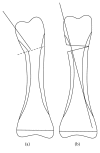Opening Wedge Osteotomy for Valgus Deformity of the Little Finger after Proximal Phalangeal Fracture in Children: Two Case Reports
- PMID: 29850327
- PMCID: PMC5932511
- DOI: 10.1155/2018/1526054
Opening Wedge Osteotomy for Valgus Deformity of the Little Finger after Proximal Phalangeal Fracture in Children: Two Case Reports
Abstract
In the treatment of posttraumatic valgus deformity of the pediatric little finger, it is usually difficult to achieve accurate correction of angular and rotational deformity using closing wedge osteotomy. We report two cases of valgus deformity of the little finger (both 11-year-old female patients) successfully treated using opening wedge osteotomy followed by intramedullary semirigid fixation with a single Kirschner wire. A wire tip inserted from the retrocondylar fossa of the proximal phalangeal head was advanced along the radial side of the intramedullary cortex after gradual opening of the osteotomy site. If needed, further fine adjustment of the rotational alignment can be performed even after K-wire insertion. Postoperatively, the gap between the little and ring fingers in the fully extended and adducted position and the finger overlapping in the fully flexed position were completely resolved. The flexibility of the pediatric bone and sagittal clearance between the wire and the inner wall of the proximal phalangeal medullary cavity allow fine adjustment of the rotational alignment even after wire insertion.
Figures








Similar articles
-
Malunions of the finger metacarpals and phalanges.Hand Clin. 2006 Aug;22(3):341-55. doi: 10.1016/j.hcl.2006.03.001. Hand Clin. 2006. PMID: 16843800 Review.
-
[MODIFIED INTRAMEDULLARY FIXATION WITH TWO Kirschner WIRES FOR EXTRA-ARTICULAR FRACTURE OF PROXIMAL PHALANGEAL BASE].Zhongguo Xiu Fu Chong Jian Wai Ke Za Zhi. 2016 Aug 8;30(8):935-938. doi: 10.7507/1002-1892.20160189. Zhongguo Xiu Fu Chong Jian Wai Ke Za Zhi. 2016. PMID: 29786219 Chinese.
-
Trapezoid rotational bone graft osteotomy for metacarpal and phalangeal fracture malunion.J Hand Surg Eur Vol. 2007 Jun;32(3):282-8. doi: 10.1016/J.JHSB.2007.01.005. J Hand Surg Eur Vol. 2007. PMID: 17321650
-
Lateral Opening-wedge Distal Femoral Osteotomy: Pain Relief, Functional Improvement, and Survivorship at 5 Years.Clin Orthop Relat Res. 2015 Jun;473(6):2009-15. doi: 10.1007/s11999-014-4106-8. Epub 2014 Dec 24. Clin Orthop Relat Res. 2015. PMID: 25537806 Free PMC article.
-
Rotational and opening wedge basal osteotomies.Foot Ankle Clin. 2014 Jun;19(2):203-21. doi: 10.1016/j.fcl.2014.02.004. Foot Ankle Clin. 2014. PMID: 24878410 Review.
References
Publication types
LinkOut - more resources
Full Text Sources
Other Literature Sources
Miscellaneous

